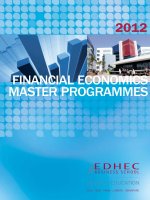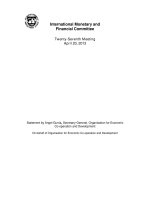MASTER MONETARY AND FINANCIAL ECONOMICS doc
Bạn đang xem bản rút gọn của tài liệu. Xem và tải ngay bản đầy đủ của tài liệu tại đây (972.53 KB, 45 trang )
1
MASTER
FINANCIAL AND MONETARY ECONOMICS
MASTER FINAL WORK
DISSERTATION
ON THE WELFARE EFFECTS OF FINANCIAL DEVELOPMENT
DIOGO MARTINHO DA SILVA
JANUARY-2013
Página 2 de 45
MASTER
MONETARY AND FINANCIAL ECONOMICS
MASTER FINAL WORK
DISSERTATION
ON THE WELFARE EFFECTS OF FINANCIAL DEVELOPMENT
DIOGO MARTINHO DA SILVA
SUPERVISOR:
BERNARDINO PEREIRA ADÃO (BANK OF PORTGUAL)
JANUARY-2013
3
ACKNOWLEDGMENTS
First of all, I want to leave my grateful to my mother Maria Lucília Oleiro Martinho da
Silva, my father, Carlos Manuel Pereira da Silva and to my sister Mónica Catarina
Martinho da Silva.
One strong motivation for make this Dissertation, is linked with the fact that Bernardino
Adão have accepted to be my supervisor. I am extremely grateful with his invaluable
advice and guidance.
All errors are mine.
Página 4 de 45
ABSTRACT
The aim of this paper is to show how the evolution of financial technology affects the
welfare in the economy. On the empirical side, I construct a time series for the costs of
financial services, and I find that the evolution shows a decreasing trend in the period
analyzed. In addition, the new statistical tool goes a long way to explaining US M1
money demand. I find that the financial costs became significantly lower after major
financial innovation events had taken place. Then I study how financial innovation,
understood as a decrease in portfolio adjustment costs, affects macro variables and
welfare.
JEL Codes: E3, E4, E5.
Keywords: financial costs, market segmentation, money demand, welfare
Página 5 de 45
CONTENTS
1. Introduction 6
2. Model 10
2.1. Firms 11
2.2. Government 12
2.3. Households 13
2.4. Competitive equilibrium 20
2.5. Economy in Steady State 21
3. Money Demand Instability and Financial Cost 23
3.1. Construct Time Series for Financial Costs 23
3.2. Money Demand Function with Financial Costs 25
4. Welfare Effects of Financial Innovation and Financial Deregulation 28
4.1. Financial Innovation and Financial Deregulation in USA (pos-1980) 29
4.2. Welfare 30
4.3. Calibration 31
4.4. Results and Comments 33
5. Conclusions 36
A. Appendix 38
A.1.Data Description 38
A.2. Steady State Equations Rewritten 39
A.3. Time Series for Financial Costs 40
References 42
Página 6 de 45
1. Introduction
The traditional monetary theory that links interest rates, money supply and inflation rate
has been called into question over the last 30 years. One explanation for this is the large
increase in technology in financial markets. In fact, over these past decades, financial
markets have been characterized by a surge in technology
1
, with the introduction of new
products and instruments
2
by banks and in financial markets with, ATMs, venture
capital, credit cards, interest rate swaps, CDS, e-banking and electronic payments.
Technology and the structure of the financial system are constantly changing, affecting
the way in which money is held.
Empirical evidence shows that financial innovations have an impact on the money
demand function, a process that started in the 1970s. This problem with the stability of
money demand began in the 1970s with Goldfeld (1973). He found that a traditional
money demand equation enabled an accurate characterization of quarterly U.S. data
during the period 1952-1972. As a result of this work, the money demand function
became the conventional money demand function used by policy makers. However,
Goldfeld (1976), extends the sample period to 1976 and reports a significant reduction
in the performance of the money demand equation. This phenomenon of instability in
the money demand function was labeled as the “case of missing money” and the most
commonly accepted explanation for this is that money demand declined as the result of
financial innovations. After this, as far as the importance of the effects of financial
innovation on understanding the relation between money demand, income and interest
1
Lerner and Tufano (2011) provide useful reviews of the literature about financial innovation.
2
For a longer description of new financial instruments see Foster et al. (2011).
Página 7 de 45
rate elasticity is concerned, a large volume of research has been undertaken and several
proxies have been used in order to capture these effects.
The research on instability of money demand has followed several directions. One
direction is that financial innovations have to some degree blurred the distinctions
between the different components of the monetary aggregates to some degree. As a
consequence, there has been a discussion about whether M1 is the best aggregate to use
in the study of money demand. For instance, Teles and Zhou (2005) argued that M1 is
the relevant measure of money since the major technological developments that have
taken place in financial markets. They focused on a monetary aggregate Money Zero
Maturity (MZM)
3
, which measures balances available immediately for transactions at
zero cost.
Another implication for the study of money demand is that financial innovation affects
both the extensive margin (the decision whether to hold interest-earning assets) and the
intensive margin (the decision on how to allocate wealth between money and interest-
earning assets). Mulligan and Sala-i-Martin (2000) reported that the fixed costs of
adopting financial innovation introduce frictions into the participation decision as a way
of explaining the reason why only 41 percent of US agents in 1989 have an interest
bearing banking account. In addition, Vissing-Jorgensen (2002) reports that these costs,
faced by households in rebalancing a portfolio, motivate the holding of money and less
participation in the financial markets.
In a model with cash-in-advance constraints faced by households, these latter seek to
3
Federal Reserve Bank defined MZM as M2 less small-denomination time deposits plus money funds.
Página 8 de 45
hold only money enough to liquidate their consumption expenses at a constant rate over
some interval of time and hold the remaining wealth in the form of non-monetary assets.
As households need to visit financial markets to transfer wealth from the bonds to
money and pay a real cost to make these transfer, it is costly for them to go to the
financial markets to adjust the composition of portfolio, but, at the same time, it is also
costly to hold money because it is an asset with no earned interest. As documented by
Edmond and Weill (2008), this (high) cost is normally required in models of market
segmentation and implies that households visit financial markets very low infrequently.
I will give special attention to the role of these financial costs (γ). My interpretation for
γ will be the real costs of visit financial markets to exchange assets with less liquidity
for money - for instance, costs associated with time spent for information meeting,
decision making, negotiation and communication or price of financial intermediation.
As suggested by Reynard (2004), a stable money demand can be obtained by a
decreasing γ combined with increasing financial market participation. However, as the
components of γ are difficult to account for, the analysis of monetary models in
literature is simplified by making them constant.
The first aim of this Dissertation is to verify if γ has been lower over the last century. To
analyze the previous point, I explain it through a general equilibrium model with
calibration of parameters at steady state values and construct the time series for γ.
Concerning the choice of a model, I construct a Baumol-Tobin model with market
segmentation, similar to the model developed by Silva (2012). In the model households
can choose freely the timing for their use of financial services, and , which appears in
budget constraint of households, influences this choice, and, thus, the money demand.
Página 9 de 45
Because the model has been constructed to study the long-run money demand when the
economy is at steady state, the series constructed can be seen as a proxy of the real
values of . I found that, in general, has followed a decreasing trend, and this
evolution goes a long way to explain the aggregate money demand over the century,
with elasticity of 1/2, and with the interest rate elasticity of money demand of –1/2.
I also confirm that the decreasing of is higher after major financial innovations and
financial regulations have been introduced. Thus, a reduction of in the model can be a
good proxy in order to catch developments in the US financial sector.
Finally, I also study how financial innovation, understood as a decrease in , affects
macro variables and welfare. For this, I made an experiment with the model and I find
that, because markets are segmented, a reduction in is beneficial for welfare because it
more than offsets the welfare costs of higher interest rates.
The structure of this paper will be organized in the following way: In Section 2, I
introduce the model used in this study, explaining the behavior of the agents in the
model (households, firms, and the government) and defining the competitive
equilibrium and steady state of the model. In Section 3, I explain the experiment that I
use to create a time series and I also present my money demand specification, in order
to explain the U.S. money income ratio. In Section 4, I introduce the social welfare
definition and study the welfare effects of the evolution of a proxy for financial
development. Finally, in Section 5, I present my conclusions.
Página 10 de 45
2. Model
Typically in the standard macro models, the moments at which households can readjust
their portfolios are exogenous. I follow a general equilibrium model where the markets
are endogenously and households manage money holdings by solving a Baumol (1952)
and Tobin (1956) problem of money as inventory segmented. Time is continuous and
denoted by
.
At any moment, there are markets for assets, consumption goods, and labor. The
markets for assets and the market for consumption goods are physically separated.
There are two assets: money and nominal bonds. As in Alvarez et al. (2002, 2009)
households owns two financial accounts, a brokerage account and a bank account. They
choose how often to transfer funds deposited in the account at the investment bank into
the money in commercial bank account. For make this transfer is involved a financial
costs . As result, households accumulate bonds for a certain time and visit infrequently
the bond market as in the models of Grossman and Weis (1983), Rotemberg (1984) and
Alvarez, Atekson and Edmond (2009).
The model also can be seen as standard cash in advance model with decision on
capital and labor like Cooley and Hansen (1989) and Cooley (1995). I follow closer the
model of Silva (2012). The difference between the model of Silva (2012) to the others
referred above is that the decision on timing to visit financial markets, that is
endougnousely chosen by households.
Página 11 de 45
2.1. Firms
At time t, individual firm hires labor and capital to produce the
consumption goods with a Cobb-Douglas technology. With the aggregate capital
and the aggregate labor
, the production function is given by:
(1)
where
is the output produced by firms, is the level of general technology taken
as given by firms and a parameter
is capital income share of total income. The
problem of perfectly competitive firms is choice the optimal mix of aggregate capital
and aggregate labor to maximize the following profit function
where is the price of consumption good produced by firms, is the nominal
wage received by the worker and
is the real rental price of capital. From the first
order conditions, profit maximization implies that firms hire capital and labor to equate
the rental rates to the respective marginal products, i.e., at
the demand for
labor and the demand for capital are, respectively, given by:
(2)
(3)
Assuming perfect mobility of production factors implies that
and
are the
same for all firms.
Página 12 de 45
2.2. Government
At moment , government issues nominal bonds,
, that pay a nominal interest rate
and prints money,
, makes consumption expenditures and receives a
Lump-sum tax paid by the households
4
. The financial responsibility is given by
total public debt
.
Let
denotes the price at time zero of a bond that pays one dollar at
time . At moment , for very small , the financial responsibility is given by total
public debt,
.
At moment
.
By multiplying both sides of constraint by and add all of them, the present
value of all budget constraint:
Because government cannot accumulate debt infinitively, imposing the No Ponzi
Games condition,
, then
4
In General case we can consider the revenues from tax capital and labor.
Página 13 de 45
Due to the government be continuously in the asset markets exchanging bonds for
money, and is very small, , thus the present value of intertemporal budget
constraint of government is given by:
,
where
is the initial public debt of government. Dividing both sides by
, where is the inflation rate, we have the budget constraint of
government in real terms:
,
(4)
where
, and
.
2.3. Households
There is a unit mass of infinitely-lived households with preferences over consumption
and leisure. Each household sells hours of labor and rents capital , to the
Página 14 de 45
firms. The problem is written assuming both the labor income,
, and the
rental income,
are deposited in brokerage account
5
.
Household
decides on consumption , labor supply , capital ,
the dates when transfers to the bank are made
, money holdings in the bank account
and bond holdings in the brokerage account . She has an initial
endowment of wealth divided between initial monetary assets
in the bank
account, initial bonds
in the brokerage account and the initial dividends from
rents capital to the firms in the brokerage account,
. The holding period
between any two consecutive transfer times is the interval
, for
.
In order to describe de model, it will be used the notation
for denotes the
position of variable x just before the transfer time at
, and
for denote
the position at transfer time
. The net transfer from the brokerage account to the
bank account is given by
, where
and
shows,
respectively, the monetary assets holding just after and before a transfer at
.
The definitions of dynamic of bonds holding in brokerage account and quantities of
capital are similar. When a household readjust portfolio at
, , it face a
constraint on the brokerage account which imposes the portfolio chosen plus costs of
adjustment
must be equal or smaller to the current wealth, i.e.,
5
Alvarez et al. (2009) and Khan and Thomas (2010) write the problem of households assuming that firms
pays 60% of total income received from households in money. Silva (2012), in the model without
decision in capital and labor by households, compare the money demand with the assumption of these
works, and with the assumption that all income is paid in non-monetary assets.
Página 15 de 45
During holding periods
, bonds and capital follow respectively
and
.
With this, and multiplying the restriction in each holding period by
, where
denotes the price in of a bond which pays one
dollar in
, substituting the restriction recursively for the different holdings period
constraint, and after sum up all them we have
.
Using the Non Ponzi Games conditions,
and
, the present value of intertemporal budget constraint
becomes:
(5)
The restrictions (5) states that the present value of money transfers and transfers fees
must be less or equal to the present value of deposits in the brokerage account, including
initials holdings of bonds and income from capital and labor. Households also have a
cash-in-advance constraint with varying holding periods
), which imposes
Página 16 de 45
that households need enough money on their bank account to be able to visit goods
markets during the whole holding period,
, The cash in advance constraints that household faces can be written as:
(6)
In this economy without uncertainty is never optimal to set
,
because it means that the agents maintained money holdings in the bank, during the
holding period
) without receiving interest. The agent is always better off
if transfer money from their brokerage account to their bank account and reducing the
amount transferred at
for transactions during the holding period until
.
However, as
is given by households, it can still be the case that
, for
The household take a King, Plosser and Rebelo (1988) utility function
6
:
Where is the elasticity of inter-temporal substitution, is the relative risk aversion
and is the relative preference parameter for leisure
.
Preferences are a function of consumption goods and labor, the financial costs do not
enter directly in utility function. At , given prices and
, agents
make their decisions in choice the vector
by
solving the following problem:
6
King et. al (1988) shows that this kind of preferences have properties consistent with steady state
equilibrium.
Página 17 de 45
subject to inter-temporal budget constraint (4) and cash in advance constraint (5).
Let
to be lagrange multiplier of budget constraint and
the lagrange
multiplier of cash in advance constraint, the Lagrangean of problem stated above is:
For
the first order condition with respect to consumption ,
leisure
, money holdings after a transfer
and timing for
make transfer at
becomes respectively:
:
(7)
:
(8)
(9)
Página 18 de 45
(10)
Inserting condition (7) in the ratio between (5) and (6) we have the intratemporal
condition between leisure and consumption, which is
. Using (5), we
get the growth rates of leisure and consumption during the holding periods, which are
respectively,
and
.
7
Thus consumption and
leisure at moment follow
and
, with
and
are the positions of initial artificial consumption and leisure respectively
in holding period. With this behavior of and , and since
, the intra-temporal condition between leisure and consumption, becomes:
, for
(11)
The condition (11) gives the position on consumption and leisure by household over
the holding period, which depends on their growths rates, nominal wages, interest rates,
the preference for leisure and the distance to the previous transfer time. Even if the size
of the holding period
is the same for all households, the hours of work
supply decreases, and leisure increases within the holding period. The expression for the
behavior of individual consumption and leisure of household at moment implies
that aggregate consumption and aggregate leisure is respectively for …
7
The setting that I will use implies
and
.
Página 19 de 45
,
and
.
As referred above, for a complete holding period, all households which make a transfer
at
starts with
for consumption and end with
. The
heterogeneity of model is in the timing of when transfers are made by households. At
any moment , the money demand of household that make transfers is
, for . From now on, I will define the
length of holding period as
, which is the same for all households.
The aggregate money demand at date is
. As individual
consumption for follows
, and
for
, substituting in expression above of
, the aggregate
money demand at moment is rewritten below:
(12)
After rearranging (10), and using (11), the optimal interval between transfers,
yields
from the positive root of
(13)
Página 20 de 45
The left side of (11) is the marginal cost of delaying the transfer and the right side of
(11) is the marginal benefit of increasing
. is the marginal benefit because
households delays the payment of the transfer cost when
rises. When we divided (9)
by
seems the term
, which is the same
as
and means that the benefit of postponing the payment depends on
the difference between nominal interest rate and inflation at
8
and financial cost.
Mulligan and Sala-i-Martin (2000) point out that a large fraction of households only
hold money because the left side is lower than the right side.
2.4. Competitive equilibrium
A competitive equilibrium is a sequence of policies, allocations and prices such that (i)
private agents (firms and households) solve their problems given the sequences of
policies and prices, (ii) the budget constraints of the government is satisfied and (iii) all
markets clear. Given a uniform distribution
9
, with density
the market clearing
conditions implies that the money and bonds demanded by households is equal to the
money and bounds supplied by government, i.e.,
and
. The labor and capital market clearing conditions are
and
Finally, the market clearing
8
As we focus on steady state with constant nominal interest rate at and inflation at and with non-
arbitrage condition an inter-temporal discount rate given by real interest rate in order to avoid
the arbitrage opportunities between bonds and goods markets, i.e., . With this appears
9
A proof that the uniform distribution is the only distribution of agents compatible with a steady state in
which agents have the same consumption pattern is in Grossman (1985, appendix B).
Página 21 de 45
conditions for goods implies that the sum of aggregate private consumption, public
consumption, financial services and aggregate investment equal the output production:
(14)
where the aggregate investment is the compensation of capital depreciated.
2.5. Economy in Steady State
The steady state is interpreted as the allocations and prices of an economy that has not
been exposed to shocks for a long time, and so the evolution of inflation rate, nominal
interest rate, aggregate consumption, aggregate capital and aggregate labor are
independent of time. I also concentrated in a steady state equilibrium where the initial
distribution of bonds, money and capital among the households is such that the
economy of the model has properties that all holding periods, have the same duration,
, and all households behave similarly during their holding periods. Thus, all
households readjust their portfolio in the same way, being equal the fraction of
households that readjust their portfolio at any moment in this interval. This means, for
example, the initially portfolio adjust is at date , and the posteriors
readjusts are at dates , for . However, the proprieties of market
segmentation are in the moment of transfer times, which are made at different times.
Página 22 de 45
To ensure the existence of a competitive equilibrium in steady state with bounded
budget sets, there are two conditions that must be held in order to avoid arbitrage
opportunities. The non-arbitrage condition between goods markets and asset markets
which states the inter-temporal discount factor is such that compensates the returns of
bounds and the growth rate of the single good price, or, in other , must be equal to the
real interest rate, i.e., . Because only one asset is needed to accomplish all
inter-temporal trades in a world without uncertainty, the second arbitrage condition
ensures that capital and bonds have the equivalent rate of real return, i.e.,
. If the left side of the last condition is higher than the right side, the household can
make its budget set unbounded by either buying an arbitrarily large capital, or in
opposite case, selling capital short with an arbitrarily negative capital.
At steady state equilibrium, the economy can be described by eight independent
equilibrium static equations (1), (2), (3), (4), (9), (10), (11) and (12)
10
, which can be
used to determine eight steady state equilibrium variables. For the experiments that I
want to do, I choice as endogenous variables, the vector
,
and the remaining variables of the model are parameters attributing it fixed values
11
.
10
In appendix I rewrite the steady state equations.
11
In order to achieve the solution of the system of nonlinear equations, I build a program in MATLAB
and use the function fmincon. The method
11
adopted is generally referred to as constrained nonlinear
optimization and, given an initial allocation for endogenous variables, it consists on minimizing an
objective function subject to a system of nonlinear restrictions identified above. The objective function is
a scalar function of the endogenous variables, and as the number on restrictions is equal to a number of
variables to be determined, the objective function can be any constant, because it does not influence the
values of at steady state. Thus without loss consistency, I fix the objective function
.
Página 23 de 45
3. Money Demand Instability and Financial Costs
3.1. A Time-Series Construct for Financial Costs
Since empirically it is extremely difficult to construct a direct measure of , I will
use indirect measures to create a time-series for this will make it possible to posit the
evolution. I construct a time-series for through calibrating the model explained in the
previous section, with annual time-series data of / and for the period 1900 to 2006.
M1 is used for the monetary aggregate,, the nominal GDP for output, , and short-
term commercial paper rate for the nominal interest rate
12
, , as in Lucas (2000) and
Wright (2005). For each annual period, the method adopted to achieve consists in
calibrating the nominal interest rate (r) with the values taken from the data, and is
calibrated in such a way that, in the general solution of the model, money-income ratio
matches these values.
In this exercise, for convenience, I assume there is no government and . With this
setting for , the King, Plosser and Rebelo (1989) utility function turns in logarithmic
function
, and has the propriety of
separable leisure and consumption, and
and
on each holding period,
i.e., consumption decreases at the nominal interest rate and leisure is constant.
Moreover, in goods markets clearing condition (10) government expenditure term does
not appear. I use a similar parameterization to that used by Silva (2012). In addition to
calibration of parameters explained above, I calibrate the model for = 3%, = 2.065,
= 10% and = 1. One important note is that the values of that will be obtained are
12
Data sources are described in appendix.
Página 24 de 45
not the real values of because the model is constructed to explain the long-run money
demand, when the economy is at its steady state. However, as we will see in the next
subsection, the created in this exercise can be seen as a very good proxy for real
quantitative values of this variable, if we consider the financial costs as being the
unexplained part of the money-income ratio.
Figure 1plots the time series of financial costs and its trend retired by the Holdrick and
Prescott (1997) filter. In general, as can be easily verified, the financial costs have
followed a downward trend.
Figure 1: Evolution of Portfolio Adjustment Cost
The evolution has a minimum of 0.0008, a maximum of 0.018 and a mean of 0.007. We
can interpret as a fraction of income or as a cost per transfer. With per capita income
of 35,000 dollars in 2000, that statistics means that the evolution of cost per transfer has
a minimum of 28 dollars, a maximum of 630 dollars and a mean of 245 dollars. If I
made the exercise dividing the annual rates by 365 would imply evolution of in days
.000
.004
.008
.012
.016
.020
00 10 20 30 40 50 60 70 80 90 00
Holdrick Prescott trend
Portfolio Adjustment Costs
Year
Página 25 de 45
per transfer with a minimum of 0.292, a maximum of 6.57 and a mean of 2.56.
13
And so
have a minimum of about one third of day per transfer, a maximum of 6.57 days per
transfer and a mean of about 2.56 days per transfer.
An important observation needs to be made about the 1930s, which were characterized
by the Great Depression and during which financial costs were very low. However,
money demand was high due to an interest rate close to zero, making households feel
less attracted to invest their income with very low return.
3.2. Money Demand Function with Financial Costs
Using data from 1900 to 1994, Lucas (2000) relates the money-income ratio to the
nominal interest rate, using
(15)
where >0 is a constant, and measures the value of interest rate elasticity of money
demand. Lucas (2000) preferred specifications set = - 1/2, consistent with a shopping
time model for money demand, and is such that matches the geometrical mean
when takes its geometrical mean.
Teles and Zhou (2005) argue that M1 was a good measure of money before the
development of the financial sector which started in the early 1980s. After that, they
focus on MZM as the most appropriate measure for money demand, and the opportunity
cost of holding money as the difference between the nominal interest rate and the
interest for some components of MZM, like NOWs, MMDAs or MMMFS. The
13
With this we can compare the values obtained with the values of Silva (2012).









